CDI 2- SPECIALIZED CRIME INVESTIGATION 1 WITH LEGAL MEDICINE
1/96
There's no tags or description
Looks like no tags are added yet.
Name | Mastery | Learn | Test | Matching | Spaced |
|---|
No study sessions yet.
97 Terms
Special Crime Investigation
Is a special study of modern techniques in the investigation of serious and specific crimes including MURDER, HOMICIDE, RAPE, ABORTION, ROBBERY, ARSON, KIDNAPPING, BLACKMAIL, CARNAPPING and CRIMINAL NEGLIGENCE.
Homicide Investigation
is the official inquiry made by the police on the facts and circumstances surrounding the death of a person which is expected to be unlawful.
Responsibilities of a homicide investigator
1. When called upon to investigate violent death, he stands on the dead man's shoes to produce his instincts against those suspects.
2. If he interprets a criminal death accidental or natural, a guilty person is set free.
3. Remember that the police is the first line of defense in the effective application of criminal justice.
Mistakes in the homicide investigation
1. The mistakes of the homicide investigator cannot be corrected.
2. The homicide investigator should not cross the three bridges which he burns behind him. It is important that competent personal adequately handle the case.
Three Bridges
a. the dead person has been moved
b. the cadaver is embalmed
c. the body is burned or cremated
Art. 246. Parricide
Any person who shall kill his father, mother, or child, whether legitimate or illegitimate, or any of his ascendants, or descendants, or his spouse.
Art. 247. Death or physical injuries inflicted under exceptional circumstances
a. any legally married person who, having surprised his spouse in the act of committing sexual intercourse with another person, shall kill any of them or both of them in the act or immediately thereafter, or shall inflict upon them any serious physical injury, shall suffer the penalty of destierro.
b. these rules shall be applicable, under the circumstances, to parents, with respect to their daughters under 18 years old and their seducer, while daughters are living with their parents.
Destierro
prohibition to enter the place for at least 25km but not more than 250km.
Art. 248. Murder
Any person who, not falling within the provisions of Article 246 shall kill another, shall be guilty of murder and shall be punished by reclusion temporal in its maximum period to death, if committed with any of the following attendant circumstances:
1. With treachery, taking advantage of superior strength, with the aid of armed men, or employing means to weaken the defense or of means or persons to insure or afford impunity.
2. In consideration of a price, reward, or promise.
3. By means of inundation, fire, poison, explosion, shipwreck, stranding of a vessel, derailment or assault upon a street car or locomotive, fall of an airship, by means of motor vehicles, or with the use of any other means involving great waste and ruin.
4. On occasion of any of the calamities enumerated in the preceding paragraph, or of an earthquake, eruption of a volcano, destructive cyclone, epidemic or other public calamity.
5. With evident premeditation.
6. With cruelty, by deliberately and inhumanly augmenting the suffering of the victim, or outraging or scoffing at his person or corpse.
Augment
increase
Scoffing
mocking
Treachery or Alevosia
means that the offended party was not given opportunity to make a defense
Evident Premiditation
the essence of premeditation is that the execution of the criminal act must be preceded by cool thought and reflection upon the resolution to carry out the criminal intent during the space of time sufficient to arrive at a calm judgment.
Art. 249. Homicide
Any person who, not falling within the provisions of Article 246, shall kill another without the attendance of any of the circumstances enumerated in the next preceding article, shall be deemed guilty of homicide and be punished by reclusion temporal.
Art. 255. Infanticide
any person who shall kill any child less than three days of age or less than 72 hours.
Homicide Investigation Procedures
1. Establishing the facts of death
2. Identifying the cadaver
3. Determination of Time of Death (Death Estimates)
Death
the cessation of life; permanent cessations of all vital functions and signs
Kinds of death (SAM)
1. Somatic/Clinical death
2. Molecular/Cellular death
3. Apparent Death/ State of Suspended Animation
Somatic Death
it is a complete, continuous, persistent cessation of respiration, circulation and almost all brain functions of an organism. It is usually pronounced by a physician or other members of the family.
Molecular Death
It is the cessation of life of the individual cells in the whole body, which occurs one at a time after somatic death.
Apparent Death
It is the state of temporary cessation of vital activities of the body or vital processes were depressed to the minimum compatible with life. This condition is not actually death although classified under the kinds of death, because the person or organism is still alive although it seems that there are no signs of life.
Signs of Death
1. Cessation of respiration
2. Cessation of Heart Beating and Circulation
3. Cooling of the Body
4. Insensibility of the body and loss of power to move
5. Changes in the eyes
6. Changes in the skin
Pelvic Bone
hip bone, are excellent indicators of the victim's sex
Age determination can be established via....
dental structure
Law of Multiplicity of Evidence
The greater the number of similarities or dissimilarities the greater is the possibility for the conclusion to be correct.
Post-Mortem Changes
1. Algor Mortis (Cooling of the body)
2. Rigor Mortis (Stiffening of the body)
3. Livor Mortis (Discoloration of the body)
4. Onset and Stage of Decomposition
5. Life Cycle of Flies
6. Changes in the Blood
7. Changes in Stomach
Algor Mortis
The cooling of the body after death, starts approximately 30 minutes after death
Changes in the Muscle after Death
1. Primary Relaxation or Flaccidity
2. Rigor Mortis/ Post Mortem Rigidity
3. Secondary Relaxation or Flaccidity
Flaccidity
condition or state in which muscles are flabby, relaxed, or have defective or absent tone, last for 1-2 hours
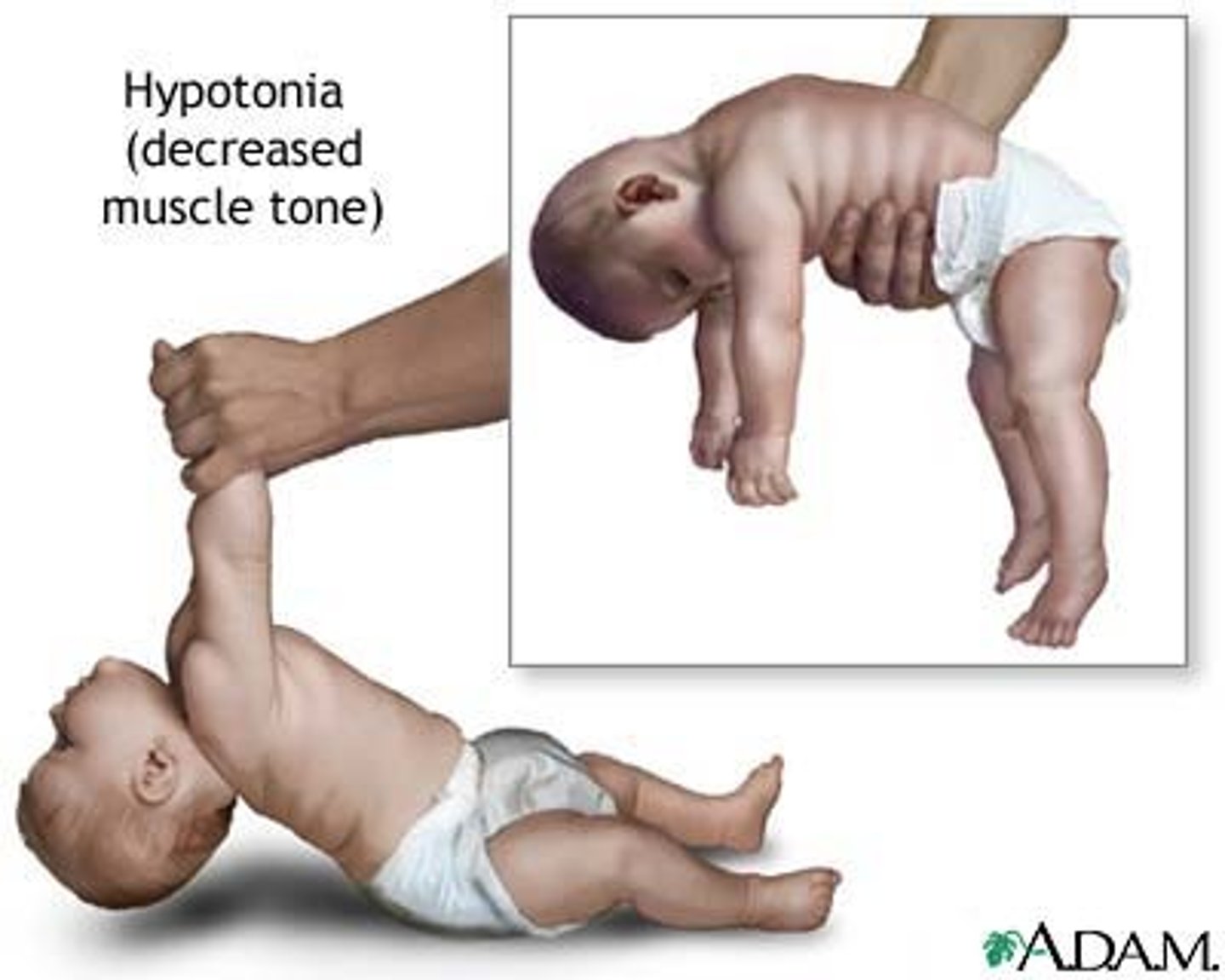
Rigor Mortis/Post Mortem Rigidity
stiffening of the body which occurs 2-6 hours after death
Duration of Rigor Mortis
- 24 to 48 hours in tropical countries
- 36 to 48 hours during summer
Cadaveric spasm (Instantaneous rigor)
is the stiffening of certain group of muscles occurring at the moment of death, usually associated with violent death due to extreme nervous tension, or even fatigue.
Difference between Rigor Mortis and Cadaveric spasm
1. Rigor Mortis appears 2 to hours after death while Cadaveric spasm appears immediately after death.
2. Rigor Mortis involves all the muscles of the body while Cadaveric spasm involves only a portion of the muscle or group of muscles.
3. Rigor Mortis occurs after death while Cadaveric spasm may or may not appear on a person at the time of death.
4. Rigor Mortis may be utilized by a medical jurist to approximate the time of death, while Cadaveric spasm may be useful to determine the nature of crime.
Secondary Flaccidity
A condition, which occurs after rigor mortis has left the body where the muscles of the body return to a state of limpness and flaccidity. Signals the start of putrefaction or decomposition due to bacteria. Noted about 48 hours after death.
Livor Mortis/Post Mortem Lividity
-discoloration of the body after death; setting of blood in the most dependent portions of the body following after death
-this pooling of blood begins immediately after death and becomes fixed approximately 8 to 12 hours
-the investigator can press on the skin in the dependent regions and if the skin blanches/pale, death has probably occurred less than 12 hours.
-this is not a reliable indicator of time of death. This is better indicator of whether the body has been moved since death.
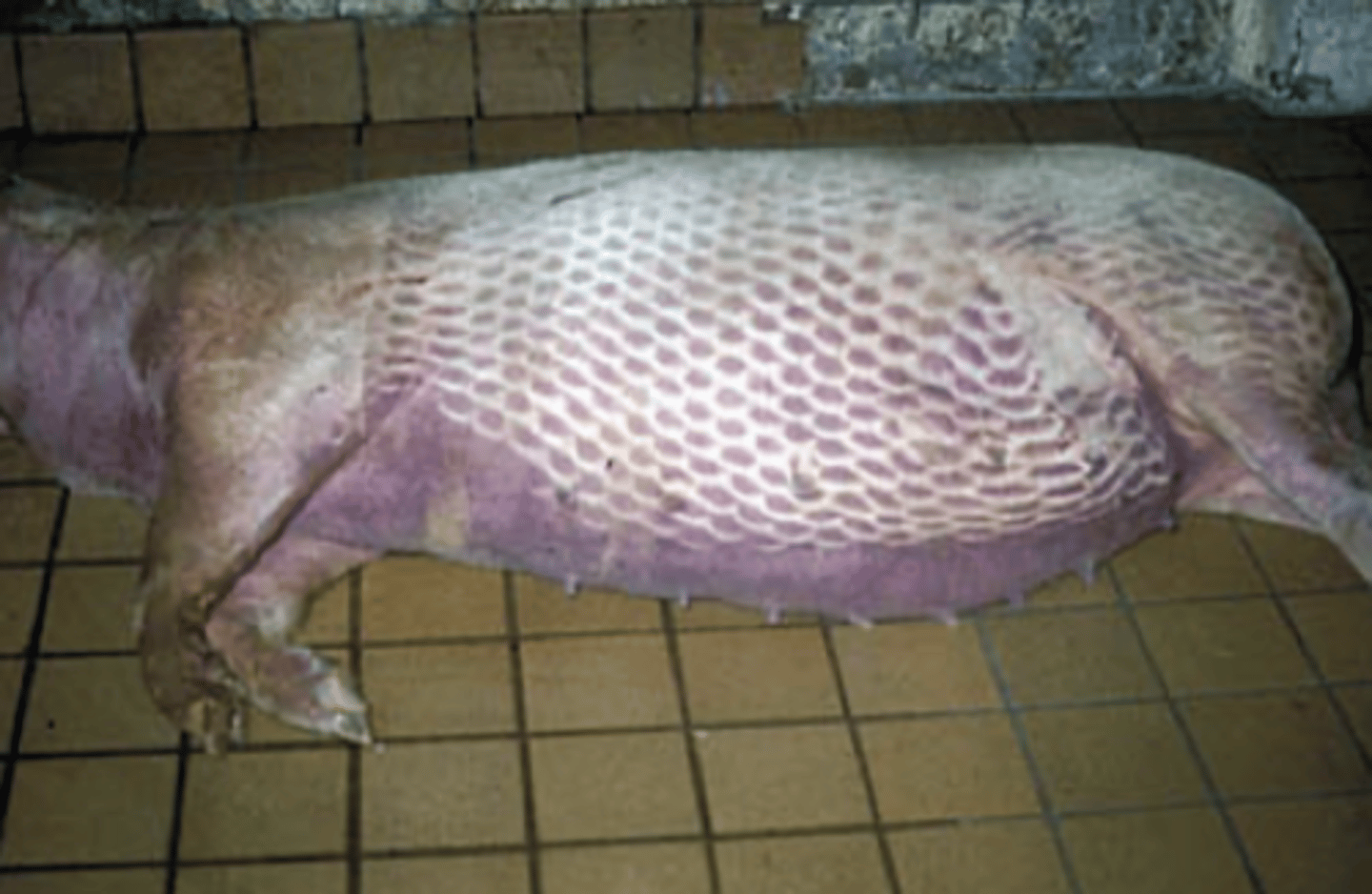
The Color of Lividity may indicate the cause of death:
1. Carbon Monoxide Poisoning/Cyanide- Bright Pink
2. Asphyxia- Dark red
3. Phosphorus Poisoning- Dark brown
Types of Lividity
1. Hypostatic
2. Diffusion
Hypostatic Lividity
Blood is still in fluid form inside the blood vessel; change as the position of the body changes. Blood remains fluid in the blood vessel for 6-8 hours.
Diffusion Lividity
coagulated inside blood vessel; change in position will not change its location
Coagualated
To cause to change to a solid
Onset and Stage of Decomposition
Decomposition is the action of bacteria on the dead body. The onset of decomposition is 2 days after death and then finally the dead body becomes skeletal remains in months considering the factors that influence the rate of putrefaction.
Putrefaction
decomposition of proteins by the action of enzymes from anaerobic bacteria
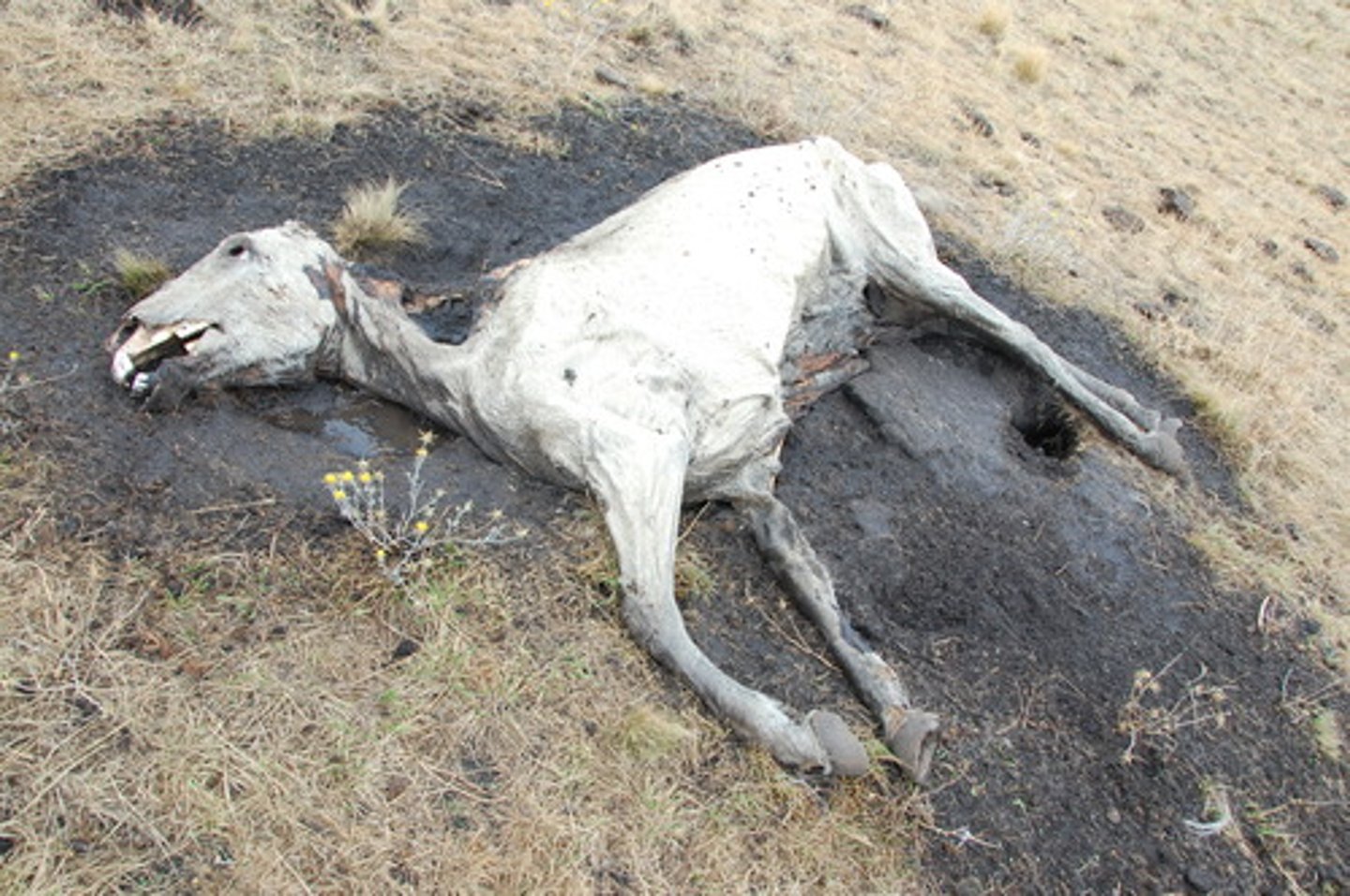
Life cycle of flies
The eggs of ova laid by the flies on the dead body will hatch to form maggots within 24 hours.
Changes in the Blood
The blood remains fluid in the body after death after 6-8 hours. After which it gradually clotted or coagulated in a slow process until 12 hours wherein the lividity was already fully developed.
Changes in Stomach
it usually takes 3-4 hours for the stomach to empty its contents after meals.
Defense wounds
Are the result of a person's instinctive reaction of self-protection. It may be found on the hand in the effort of the victim to grasp the wounding instrument or by raising the hand to protect the vital parts of the body. Absence of a defense wound does not eliminate the possibility that the victim made some form of defense.
Classification and Characteristics of Wounds (CHAISPL)
1. Contusion
2. Hematoma
3. Abrasion
4. Incised wound
5. Stab wound
6. Punctured wound
7. Lacerated wound
Contusion (bruise)
an injury in the substance of the skin, discoloration of the surface due to extravasation of blood. Contusion is the medical term for bruise.

Hematoma
a solid swelling of clotted blood within the tissues.

Abrasion
an open wound characterized by the removal of the epithelial layer of the skin brought about by the friction against hard, rough object.
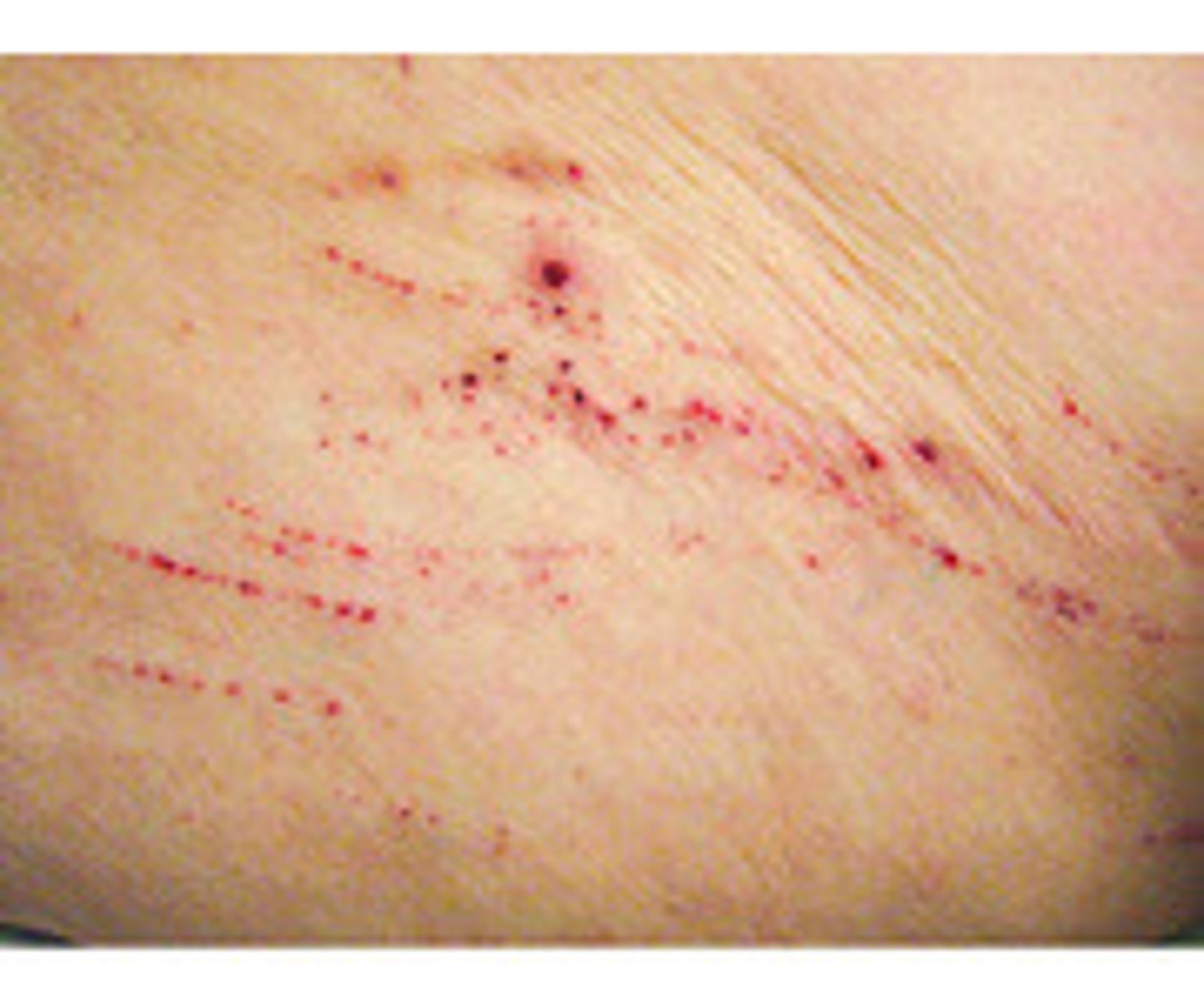
Incised wound
clean, straight cut produced by a sharp edge instrument like knife, razor, or bolo.

Stab wound
produced by the forcible application and penetration of a sharp instrument.
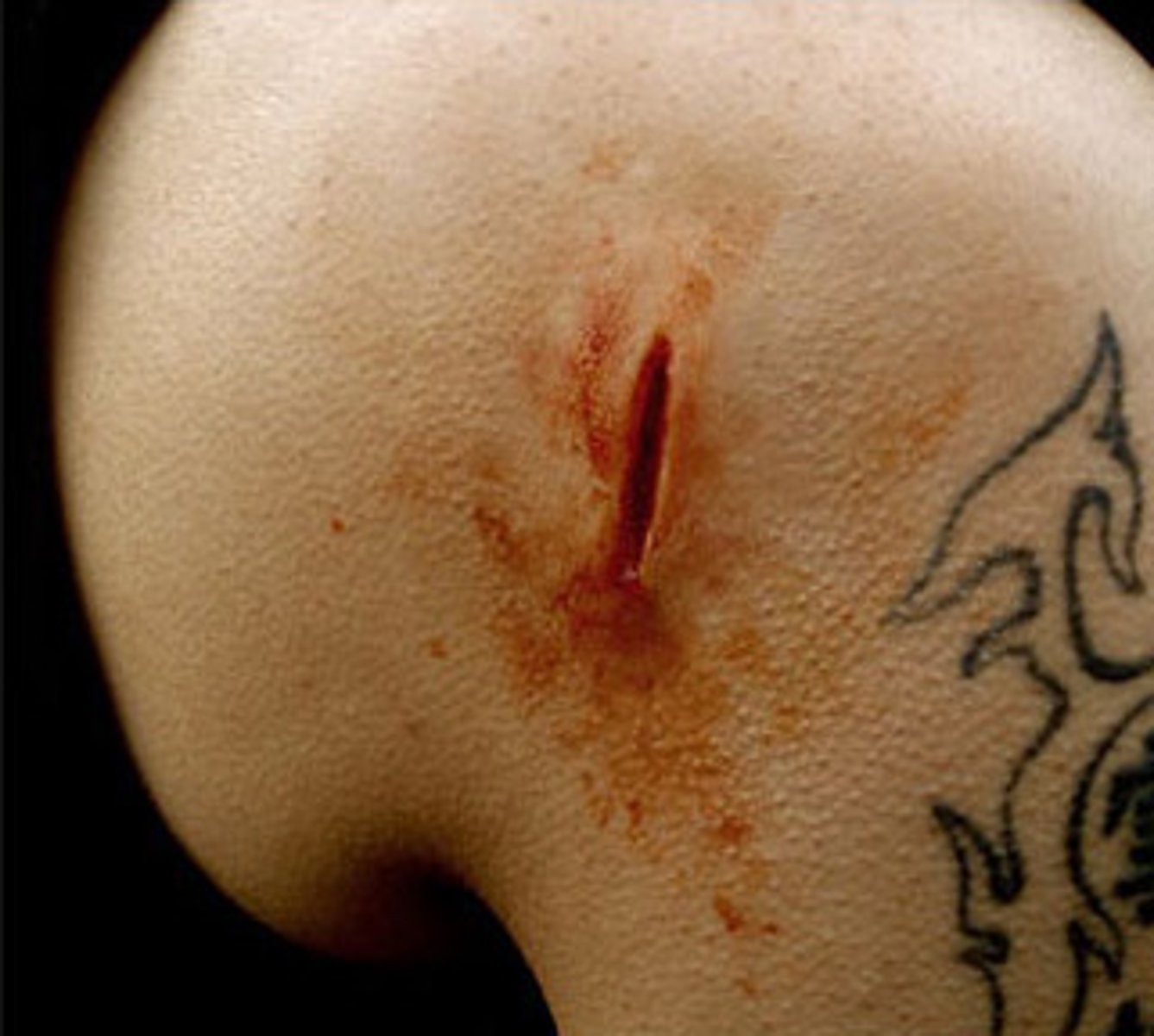
Punctured wound
penetration of a sharp pointed weapon

Lacerated wound
tearing of the skin due to forcible contact of blunt instrument

Ranges of Fire
1. Contact Range
2. Intermediate Range
3. Distant Range
Contact Range
the muzzle of the gun touches the skin, clear muzzle imprint, gray black discoloration
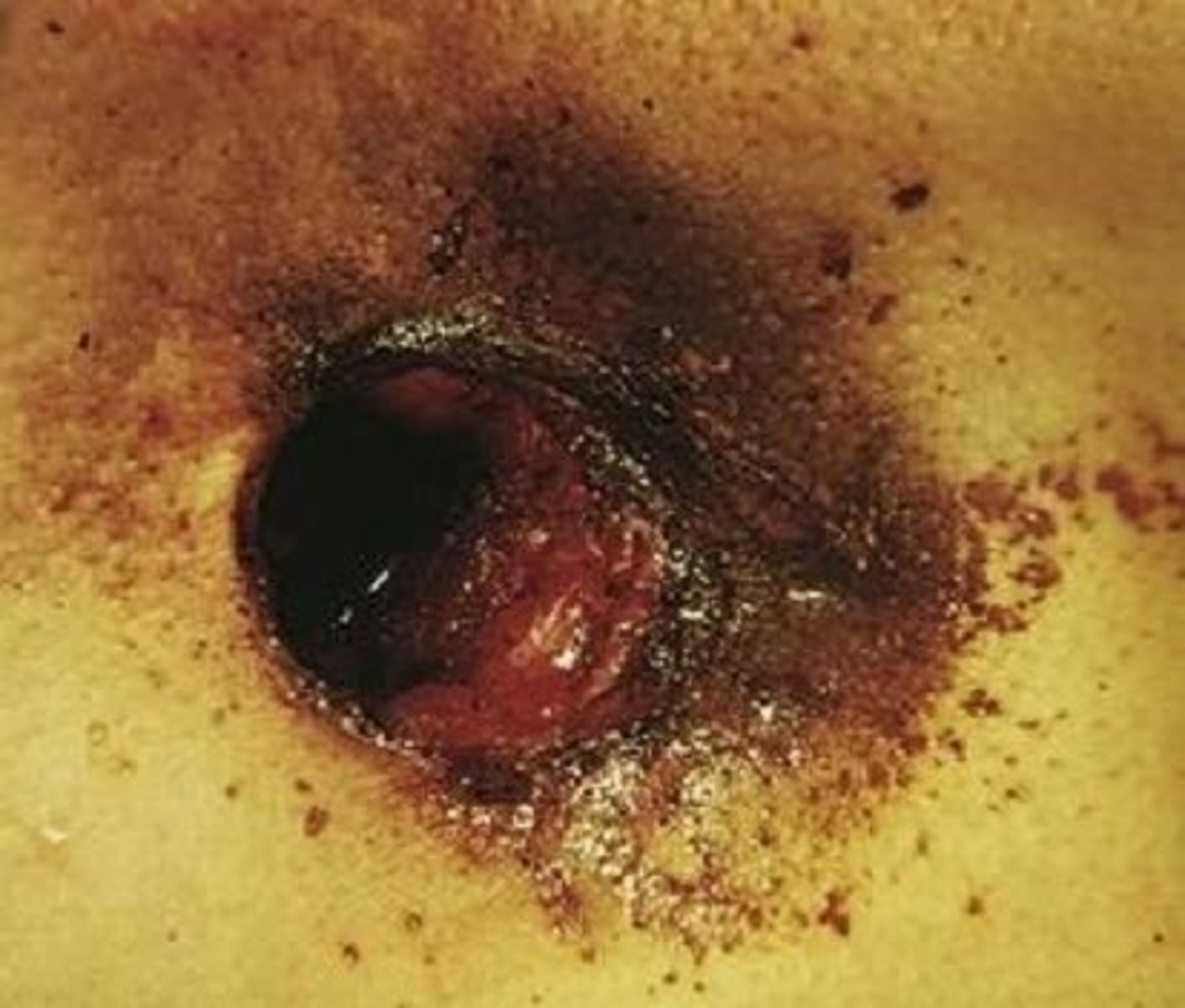
Intermediate Range
is one in which the muzzle of the weapon is away from the body at the time of discharge yet is sufficiently close so that powder grains emerging from the muzzle strike the skin producing powder tattooing.
Distant Range
the muzzle of the weapon is sufficiently far from the body so that there is neither deposition of soot nor powder tattooing.
Two Types of Gunshot wounds
1. Entrance wound
2. Exit wound
Entrance wound
surrounded by a reddish brown area of abraded skin; small amounts of blood escape through.
Exit wound
larger and more irregular in appearance; no abrasion ring; there is far more blood escapes
Asphyxia
the loss of consciousness that occurs when the body cannot get the oxygen it needs to function
Accidental Death
Is death which occurs beyond the sway of ones will and although it comes about through some act of will, lies beyond the bounds of human forceable consequences.
Locard's Exchange Principle
it states that whenever someone enters or exits an environment, something physically is added to and removed from the scene.
Glass
transparent fusion product of inorganic materials that have cooled to a rigid state without crystallizing
Radial cracks
cracks formed on the side opposite the side of the impact, radiate out in all directions from the point of impact
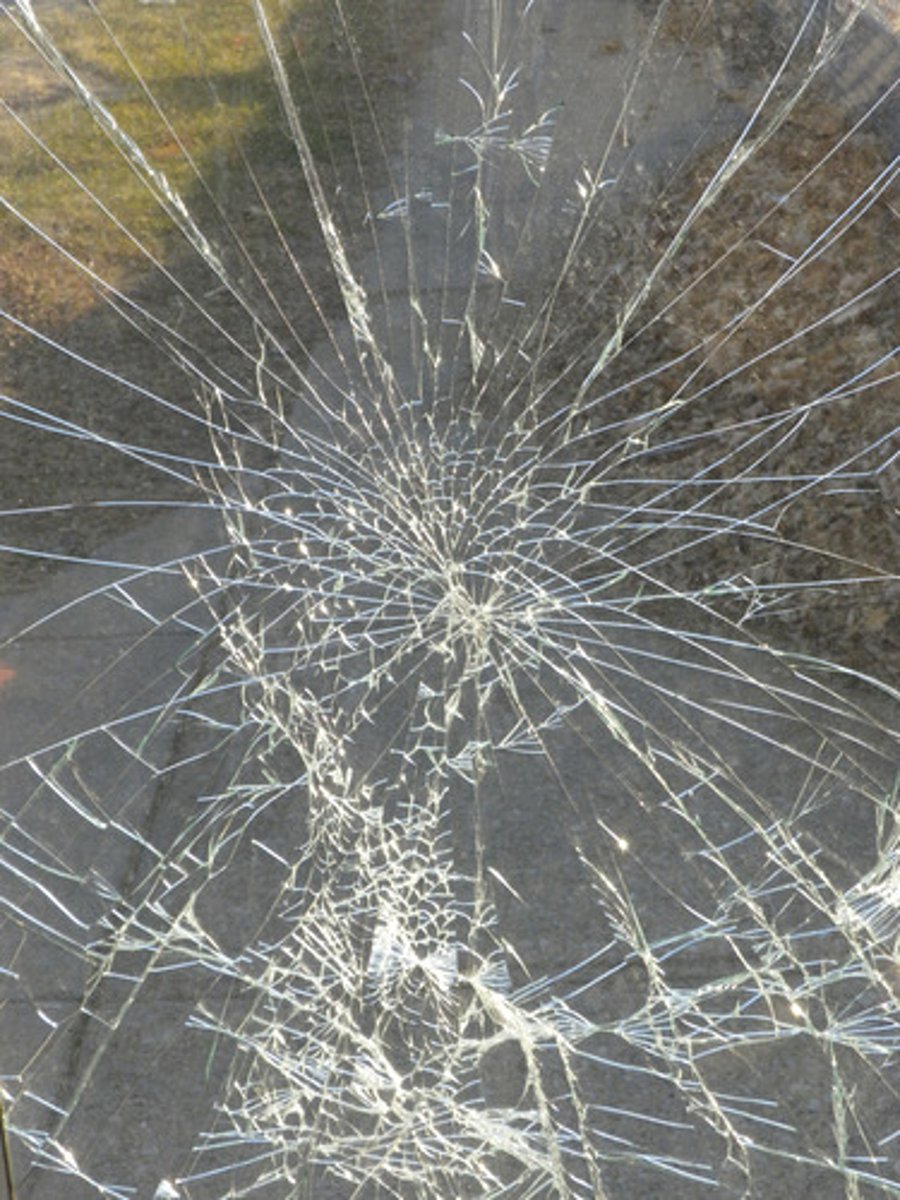
Concentric cracks
cracks that appear as an imperfect circle around the point of fracture
Types of Blood Stains
1. Passive
2. Transfer
3. Projected or Impact
Passive stain
typically result from gravity acting on an injured body
- Drops
- Flows
- pools

Transfer stain
A bloodstain resulting from contact between a blood-bearing surface and another surface.
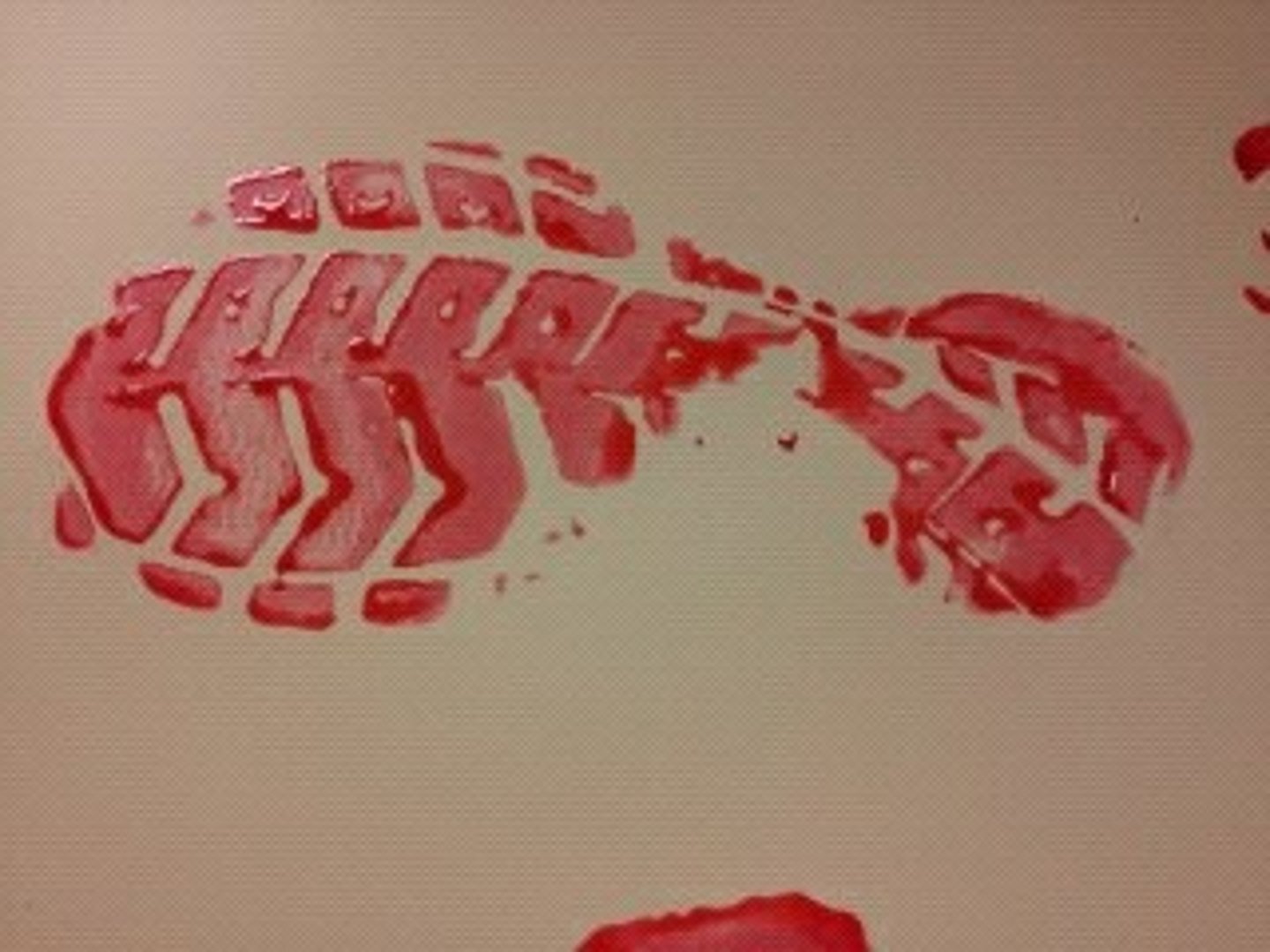
Projected stain
also known as impact stains; pattern that occurs when a force is applied to the source of the blood, includes low, medium, or high velocity spatters, cast off, arterial spurting, expiratory blood blown out of the nose, mouth or wound. Usually seen as spatter.

Blood Spatter
is defined as a dispersion of blood spots of varying size created when a source of fluid blood is subjected to external force
RA 8353
Anti-Rape Law of 1997
Two kinds of Rape
1. Rape through sexual intercourse
2. Rape through sexual assault
Rape through sexual intercourse
By a man who shall have carnal knowledge of a woman under any of the following circumstances:
"a) Through force, threat, or intimidation;
"b) When the offended party is deprived of reason or otherwise unconscious;
"c) By means of fraudulent machination or grave abuse of authority; and
"d) When the offended party is under twelve (12) years of age or is demented, even though none of the circumstances mentioned above be present.
Rape through sexual assault
by inserting his penis into another person's mouth or anal orifice, or any instrument or object, into the genital or anal orifice of another person.
Note under 8353
1. A male or female can now commit rape
2. Introduced the principle of marital rape
RA 8049
Anti-Hazing Law of 1995
RA 11053
Anti-Hazing Act of 2018
Hazing
refers to any act that results in physical or psychological suffering, harm, or injury inflicted on a recruit, neophyte, applicant, or member as part of an initiation rite or practice made as a prerequisite for admission or a requirement for continuing membership in a fraternity, sorority, or organization including, but not limited to paddling, whipping, beating, branding, forced calisthenics, exposure to the weather, forced consumption of any food, liquor, beverage, drug or other substance, or any other brutal treatment or forced physical activity which is likely to adversely affect the physical and psychological health of such recruit, neophyte, applicant, or member. This shall also include any activity, intentionally made or otherwise, by one person alone or acting with others, that tends to humiliate or embarrass, degrade, abuse, or endanger, by requiring a recruit, neophyte, applicant, or member to do menial, silly, or foolish tasks.
Initiation or Initiation Rites
refer to ceremonies, practices, rituals, or other acts, weather formal or informal, that a person must perform or take part in order to be accepted into fraternity, sorority, organization as a full-fledged member. It includes ceremonies practices , rituals, and other acts in all stages of membership in a fraternity, sorority, or organization.
Organization
refers to an organized body of people which includes, but it is not limited to, any club, association, group, fraternity, and sorority. This term shall include the Armed Forces of the Philippines (AFP), the Philippine National Police (PNP), the Philippine Miltary Academy (PMA), the Philippine National Police Academy (PNPA), and other similar uniformed service learning institutions.
Schools
refer to colleges, universities, and other educational institutions.
Essential Provisions in RA 11053
-A written application to conduct initiation rites shall be made to the proper authorities of the school not later than seven (7) days prior to scheduled initiation date
-The written application shall indicate the place and date of the initiation rites and the names of the recruits, neophytes, or applicants to be initiated and the manner by which they will conduct the initiation rites
-The initiation rites shall not last more than three (3) days
Monitoring of Initiation Rites
The head of the school or an authorized representative must assign at least two (2) representatives of the school to be present during the initiation. It is the duty of the school representatives to see to it that no hazing is conducted during the initiation rites and to document the entire proceedings.
Essential Provisions in RA 8049
-The owner of the place where hazing is conducted shall be liable as an accomplice, when he has actual knowledge of the hazing conducted therein but failed to take any action to prevent the same from occurring.
-If the hazing is held in the home of one of the officers or members of the fraternity, group, or organization, the parents shall be held liable as principals when they have actual knowledge of the hazing conducted therein but failed to take any action to prevent the same from occurring.
-The school authorities including faculty members who consent to the hazing or who have actual knowledge thereof, but failed to take any action to prevent the same from occurring shall be punished as accomplices for the acts of hazing committed by the perpetrators.
-The officers, former officers, or alumni of the organization, group, fraternity or sorority who actually planned the hazing although not present when the acts constituting the hazing were committed shall be liable as principals. A fraternity or sorority's adviser who is present when the acts constituting the hazing were committed and failed to take action to prevent the same from occurring shall be liable as principal.
-The presence of any person during the hazing is prima facie evidence of participation therein as principal unless he prevented the commission of the acts punishable herein.
RA 7877
Anti-Sexual Harassment Act of 1995
Work, Education or Training -Related, Sexual Harassment Defined
Work, education or training-related sexual harassment is committed by an employer, employee, manager, supervisor, agent of the employer, teacher, instructor, professor, coach, trainor, or any other person who, having authority, influence or moral ascendancy over another in a work or training or education environment, demands, requests or otherwise requires any sexual favor from the other, regardless of whether the demand, request or requirement for submission is accepted by the object of said Act.
In a work-related or employment environment, sexual harassment is committed when:
The sexual favor is made as a condition in the hiring or in the employment, re-employment or continued employment of said individual, or in granting said individual favorable compensation, terms of conditions, promotions, or privileges; or the refusal to grant the sexual favor results in limiting, segregating or classifying the employee which in any way would discriminate, deprive ordiminish employment opportunities or otherwise adversely affect said employee
In an education or training environment, sexual harassment is committed:
(1) Against one who is under the care, custody or supervision of the offender;
(2) Against one whose education, training, apprenticeship or tutorship is entrusted to the offender;
(3) When the sexual favor is made a condition to the giving of a passing grade, or the granting of honors and scholarships, or the payment of a stipend, allowance or other benefits, privileges, or consideration; or
(4) When the sexual advances result in an intimidating, hostile or offensive environment for the student, trainee or apprentice.
RA 11313
Safe Spaces Act (Bawal Bastos Law)
Catcalling
refers to unwanted remarks directed towards a person, commonly done in the form of wolf-whistling and misogynistic, transphobic, homophobic, and sexist slurs
Misogynistic
strongly prejudiced against women
Gender
refers to a set of socially ascribed characteristics, norms, roles, attitudes, values and expectations identifying the social behavior of men and women, and the relations between them
Gender identity and/or expression
refers to the personal sense of identity as characterized, among others, by manner of clothing, inclinations, and behavior in relation to masculine or feminine conventions. A person may have a male or female identity with physiological characteristics of the opposite sex in which case this person is considered transgender:
Public Spaces
refer to streets and alleys, public parks, schools, buildings, malls, bars, restaurants, transportation terminals, public markets, spaces used as evacuation centers, government offices, public utility vehicles as well as private vehicles covered by app-based transport network services and other recreational spaces such as, but not limited to, cinema halls, theaters and spas
Stalking
refers to conduct directed at a person involving the repeated visual or physical proximity, non-consensual communication, or a combination thereof that cause or will likely cause a person to fear for one's own safety or the safety of others, or to suffer emotional distress.